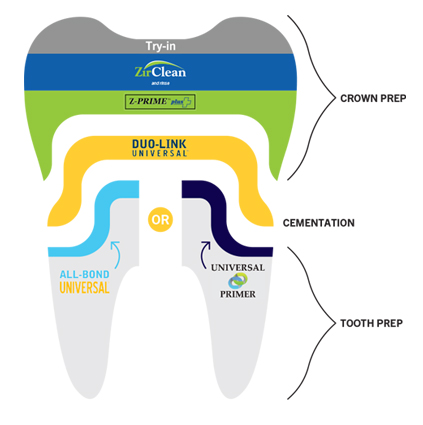The person up there on stage always seems to have it better than me. Their composite restorations somehow never result in sensitivity, their extractions never result in infection or dry socket, and their crowns all have beautiful margins, occlusal anatomy, and never come off.
Returning home to my practice, with my mediocre clinical skills, when patients would agree to treatment of any kind, there was always a small voice in the back of my head, reminding me of that one patient, a few weeks, ago, who can’t chew on that new crown, and that other patient from a few months ago, who shreds their floss around that new class II restoration that I worked so hard on.
I truly wanted to be the best possible dentist, but reality was annoyingly standing in the way.
Zirconia crowns have created a revolution in general dentistry. They are so strong, so durable, and often, quite beautiful. When I first became a dentist in the early 2000s, my material choices for long term indirect restorations all seemed to have limitations. A lot of those have been eliminated with the incredible growth in the advent of Zirconia.
There was only one problem. While they wouldn’t break, they would come off more often than the PFMs that they replaced. Patients would quickly forget about the fact that their new crown didn’t have a dark line near the gingiva, or that their new crown could be hit with a hammer without breaking, or that I didn’t need to hyper-reduce the occlusal surface of my prep, or that the anatomy was so pretty. They would remember, however, how this is the second time that the new crown has come off in less than a year.
It was time to reach out to those annoying dentists. The ones who did full arch cases on a daily basis. The ones who owned those really expensive cameras and actually used them. The same annoying CE dentists who took pictures of their amazing houses and beautiful families and their six-pack abs and somehow interwove their superiority in dentistry and life into the content of their lecture slides. It was time for me to ask them, in no un-certain terms, what they were doing that I wasn’t.
Here is a very limited list of everything they said:
-
Selective etch
-
Use bioactive composites
-
Rubber dam everything, every time, as much as possible
-
Use the gow gates method to anesthetize the mandible
-
Drill less, air abrade more
-
Use your intra-oral camera for greater magnification and to identify areas you might have missed
-
Quit being so whiney
DOWNLOAD THE ABC'S OF ZIRCONIA BONDING
Ok, ok, but what about my zirconia crowns that come off, especially 18 and 31, where I really can’t prep more retentive walls without violating biologic width?
The answer, while not simple, was consistent, and it wasn’t at all what I was already doing. Here it is:
-
Try on the crown and do whatever adjustments and polish are needed
-
Air-abrade/sand-blast the inside of the crown
-
Use a crown detergent like Ivoclean or ZirClean to remove impurities and residual sand from the inside of the crown. Make sure to scrub it in as recommended, and rinse it off well
-
Dry the inside of the crown
-
Dry the tooth
-
(Optional, but I do this especially if the tooth has been endodontically treated) - etch the tooth, especially any enamel at the margins
-
Apply primer to the inside of the crown. Follow manufacturer’s instructions.
-
Apply bonding agent to the tooth. Follow manufacturer’s instructions.
-
Then (finally), mix a dual-cure resin cement, apply to the inside of the crown, and seat it
-
Cure for a couple seconds
-
Remove the excess cement (this is very easy and quite satisfying with certain types of cement)
-
Fully cure

Is this necessary for all cementation? No. Often, ideal prep retentive design requires no crafty highly evolved cementation technique and technology. However, as you know, dentistry is messy, and rarely ideal.
Dentistry continues to provide difficult, messy, and unpredictable clinical episodes, but, happily, crowns needing re-cementation no longer are a part of that list. Now if only I can figure out how to eliminate all the others. . .
Prepared by Ankur Gupta, DDS